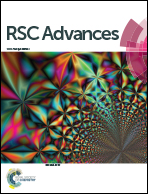The fabrication of an Ni6MnO8 nanoflake-modified acupuncture needle electrode for highly sensitive ascorbic acid detection
Abstract
The current work describes the use of a steel acupuncture needle as an electrode substrate in order to construct an Ni6MnO8 nanoflake layer-modified microneedle sensor for highly sensitive ascorbic acid detection. For the purpose of constructing the functionalized acupuncture needle, first, a carbon film was layered on the needle surface as the seed layer. Subsequently, a straightforward hydrothermal reaction-calcination process was employed for the growth of Ni6MnO8 nanoflakes on the needle to function as a sensing interface. Electrochemical investigations illustrated the fact that the Ni6MnO8 nanoflake-altered acupuncture needle electrode manifested outstanding efficiency toward the amperometric identification of ascorbic acid. In addition, the electrode manifested elevated sensitivity of 3106 μA mM−1 cm−2, detection limit of 0.1 μM, and a broad linear range between 1.0 μM and 2.0 mM. As demonstrated by the results, the Ni6MnO8 nanoflake-modified acupuncture needle constitutes a potentially fresh platform to construct non-enzymatic ascorbic acid sensors.



 Please wait while we load your content...
Please wait while we load your content...